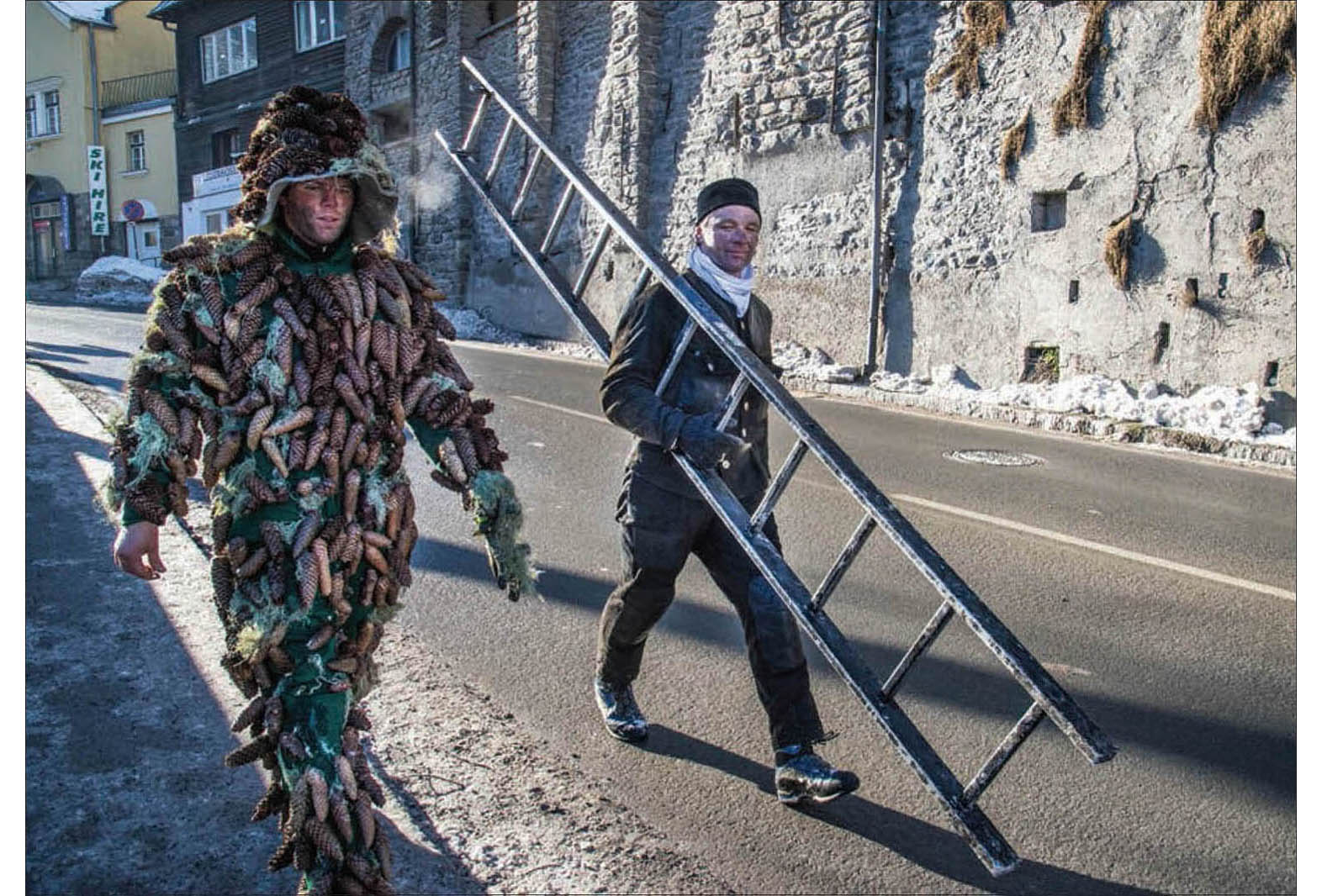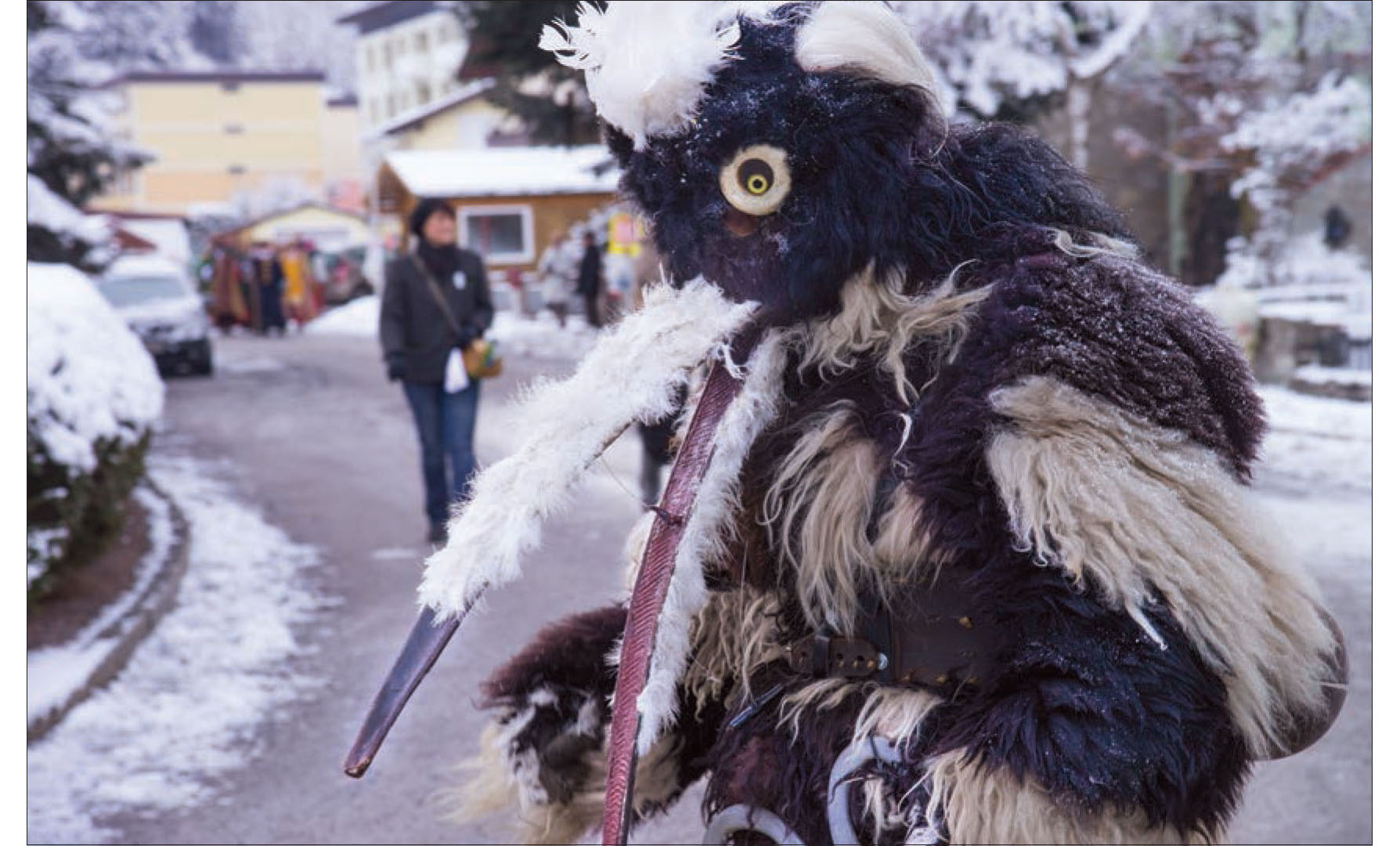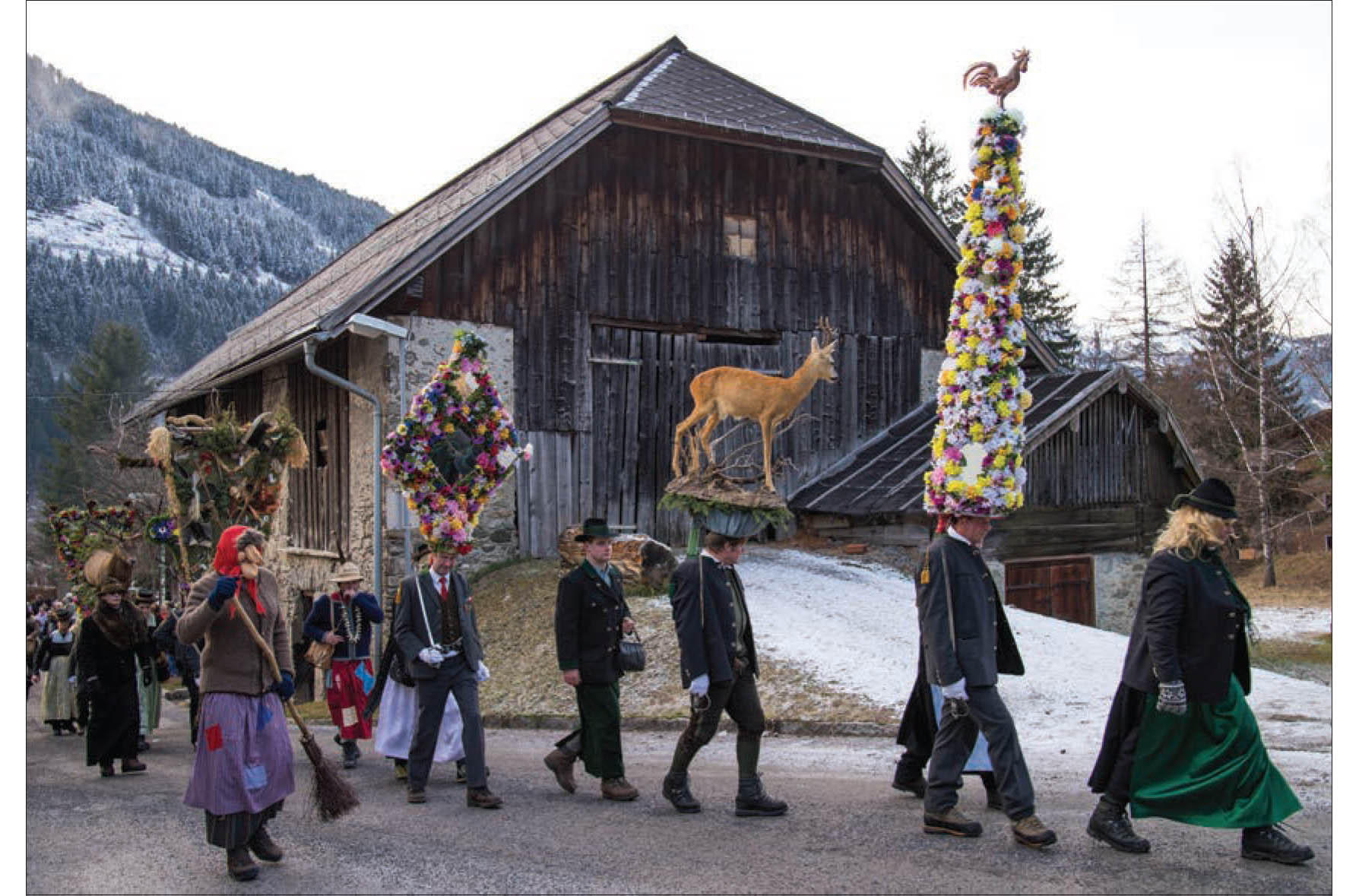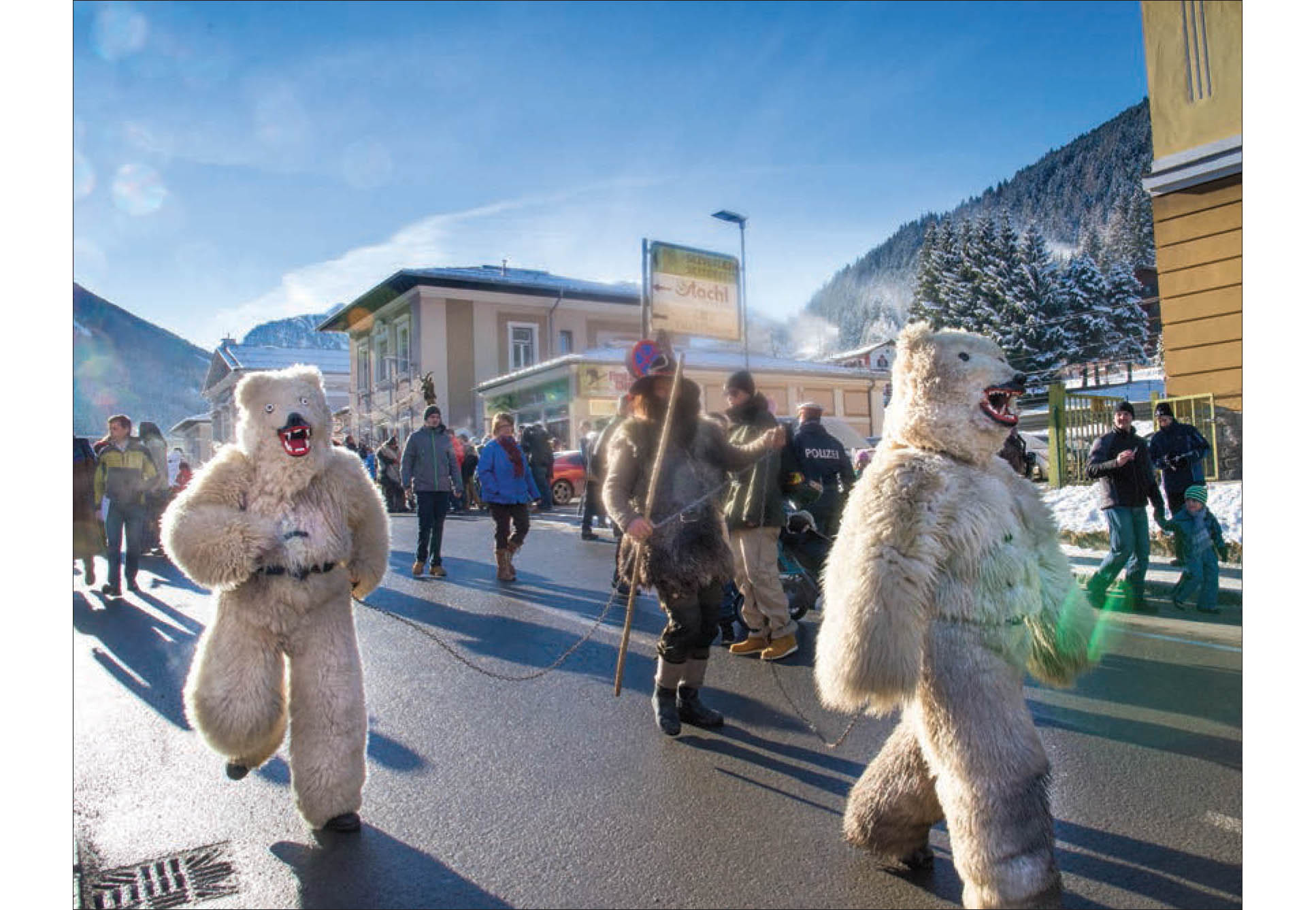

Chimney sweep and Zapfenmandl (“Pinecone Man”) at Perchtenlauf, Gastein, Austria. Photo ©Gasteinertal.com.
On the Roofs
Before the parade has even begun, forest Perchten represented by the mossy Baumwercher and pinecone-studded Zapfenmandl have begun their ascent of overlooking roofs and balconies. They are joined on their perches by the Chimney Sweep. Here—as in England, Germany, Poland, and the Czech Republic—the sweep is regarded as a good-luck symbol, one particularly associated with the New Year in Austria and Germany, where they appear as small marzipan figures or as ornaments attached to floral bouquets given on the holiday.
The Horsemen, Lead-Devil, and Bell-Carrier
Leading the parade are the Rösselreiter, hobbyhorse riders dressed in old imperial cavalry uniforms and armed with whips. Their whip-cracking reflects the tradition of Aperschnalzen, a form of synchronized whip-snapping performed at certain Carnival and Rauhnacht events. “Aper” is a (very Alpine) adjective for “snow-free,” and the noise of their whips is said to drive back the winter and its snows. The whip-crackers are followed by a single Vorteufel (“Chief Devil”) costumed like a Krampus but carrying a pitchfork rather than switches. After him comes the Glockenträger (“bell-carrier”) who wears upon his back a wooden frame hung with cowbells and decorated with both wintery pine boughs and flowers representing spring.
The Captain and Band
The Captain of the Perchten (Perchtenhauptmann) enters next, dressed in the green tailcoat, long lederhosen, and tall felt hat traditional to the Gastein Valley. It is his duty to deliver the rhymed blessing upon each location visited, and certain touches such as his white gloves, medallions, and saber emphasize the dignity of this role. Formerly, he appeared in military uniform and sported a long dignity-enhancing beard made of wool. He is usually in the company of a small band of folk musicians, performing on trumpet, clarinet, and accordion.
The Perchtenhauptmann’s duties go far beyond the ceremonial. He must ensure that all participants are over the age of 16, do not make excessive use of alcohol before or during the parade, and that masked performers do not remove their masks within view of spectators. He also presides over planning meetings, and is tasked with ensuring the success of the parade in all of its logistical detail, from the selection of the route down to the food served during the midday break.
The Cap Wearers
Following the Captain and musicians is the core of the Perchtenlauf, the 30 Schönperchten known as Tafelkappen (“board caps”) thanks to their flat surfaces, which are adorned primarily with mirrors and flowers. A variety of other decorative materials may supplement this, including garlands, decorative chains, dolls in folkloric costume, Christmas tree ornaments, and collections of old jewelry. Many are topped with scaled-up versions of the Gamsbart, that tuft of fur resembling a shaving brush found on Alpine hats and traditionally cut as a hunting trophy from the beard of the alpine chamois.
More wearable parade-float than hat, these structures (which can tower up to 8’ overhead and weigh over 100 lbs.) are supported by special neck and back braces mostly hidden under the wearer’s coat. These braces facilitate the dangerously deep ceremonial bow executed by these figures at certain points along their parade route. This bow follows the rhymed blessing delivered by the captain and a slow, twirling dance that sets the caps’ mirrors flashing in the Alpine sun.

Schnabelpercht (“Beaked Percht”) at Perchtenlauf, Gastein, Austria. Photo ©Gasteinertal.com.
There is a fair amount of variety among the 30 caps. An unusual specimen covered in black velvet, flowers and glass crystals pays tribute to the local mining industry, displaying miner’s pick and hammer along with the heraldic seals of the area’s five prominent mining families.
Of the five caps displaying stuffed animals, the most noteworthy perhaps is one first worn in 1830, before the Perchtenlauf was organized into its current form. Periodically repaired and remodeled, it now displays the head of a deer, arrays of antlers, two species of mountain goat, a fox, marmots, and weasel. While most caps do not have a lineage so old, many tend to be kept within certain families, and are therefore sometimes called Hauskappen (“house caps”).
A particularly interesting Tafelkappe represents a Schiachpercht. In times gone by, this was covered in dead rats, birds, and snakes, though today it’s sadly toned down, displaying only moderately distasteful items like mousetraps, mire-stained stable shoes, and other debris. The saber carried by the wearer is rusted, and he and his feminized partner are also dressed in patched, ragged clothes adorned with straw and chicken feathers suggesting farmyard filth. His partner wears a necklace of potatoes and clothespins.
The “women” accompanying the cap-wearers tend to be the junior members of the Perchten community, apprenticing in the role while their features are still less noticeably masculine. They are picked by the wearers of the caps not only as dance partners but also as assistants to help them don and secure the immense structures worn on their heads.

Perchtenlauf, Gastein, Austria. Photo ©Gasteinertal.com.

Bears and bear wrangler at Perchtenlauf, Gastein, Austria. Photo ©Gasteinertal.com.
Bear and Clowns
A bear costumed in furs and carved mask “controlled” by a rustically dressed wrangler follows the Tafelperchten. The wrangler’s beastly companion and the long chain connecting the two serve as a sort of barrier to keep distance between spectators crowding in to see the cap-wearers. The bear—who’s sometimes said to represent the winter and its terrible powers—was joined in 1978 by a Schnabelpercht (the “beak Percht” mentioned previously), and a Habergeiß in 1982.
Other clownish characters trail behind mingling with and entertaining the crowd. Among them, a fool, who may be called either Hanswurst or Bajazzl, an Austrian version of an Italian Carnival clown name “Bajazzo.” There are two differently costumed versions of this figure, a schön and schiach, both carrying a doll on a rope like the Lapp and Lappin accompanying the Tresterer.
The Tradesmen
The other roving performers taking part represent caricatures of old-fashioned tradespeople who engage spectators with well-worn routines and comic business employing prop tools of their trades. While mostly added in the last decades, some of them, like the quack doctor, make similarly comic appearances in Nicholas parades dating back centuries and reflect the peasant humor of the “Everyman” scenes from those plays. They are not really Perchten, and their presence may seem strange, but such itinerant merchants and handymen were a sort of traditional entertainment in old Gastein, bringing news, gossip, and perhaps comic stories and jokes intended to drum up business. Coming from other regions in Austria, Germany, and Italy, their accents and curious customs would also be a source of local humor.
Perhaps the most mischievous of these would be the Tailor, who—like the Blacksmith nailing shoes to the floor in old Nicholas plays—will sometimes set about stitching together unwary parade-goers. More commonly, he is now equipped with a toy called “stretch scissors,” an arrangement of wooden slats hinged to extend deep into the crowd and grasp or knock off spectators’ hats.
A Knife Sharpener equipped with a replica grinding stone roams about, distributing small foil razor blades inscribed with a pentagram for good luck. A traveling junk salesman and handyman similar to a tinker called a Rastelbinder (from “binder or pieces”) hawks old mousetraps, bras, and other items offering gag potential. A Postman in old imperial uniform delivers random and misdirected letters, and a Hunter and Poacher act out a comic rivalry complete with guns firing blanks.
Biblical Figures
Also interacting with the crowd are figures from the Biblical world. At the event staged on Epiphany, “Three Kings’ Day” in German, these figures join the parade, singing in four-part harmony and carrying a wooden reproduction of the Bethlehem star atop a pole. They are Sternsinger (“star singers”), carolers who around Epiphany go door to door with their star in imitation of the Three Magi. The tradition, which dates back to the 16th century, is widespread not only in Austria and Germany but is also found in Poland, Slavic Europe, Scandinavia, and in the UK, where they are called “star boys.”
The Biblical King Herod, who solicited from the Three Kings the location of the infant Christ, is also represented, as is his wife. Likely inspired by the figure in the medieval plays, Gastein’s representation of Herod deviates from the usually monstrous characterization, instead making comic use of the king. He presides over mock trials of locals he accuses of various “crimes.” Offenses, for which token fines are demanded, might include stinginess toward employees, price gouging, bragging, whining, or watering down drinks in a tavern.

Schiachperchten, Witches, and Perchta
Though today they march with their brooms and wooden masks alongside the Tafelperchten, until the 1950s, it was the witches who served Herod by rounding up miscreants. Today that duty falls to Krampus-like Schiachperchten. It’s noteworthy that unlike the modernized Perchtenlauf, consisting exclusively of large mobs of these devils, the number of Schiachperchten in Gastein is limited to four.
Finally, there is Frau Perchta. She also holds a doll as a symbol of fertility. Along with several witches, she tends to wander in the shadow of the eye-catching Tafelperchten. That she is relegated to this peripheral station seems to conflict with the historical importance the character’s assigned elsewhere. Stranger still, the figure of Frau Perchta is missing from the earliest accounts of the Gastein parade. She was, in fact, not added until 1982. Being without precedent in the local folk-art tradition, the mask Perchta wears is likely inspired by the 1949 Kirchseeon model or perhaps even the studio-created mask for the 1934 film The Prodigal Son.
This again raises the question of Frau Perchta’s place in the established Perchten mythology or within the history of the Perchtenlauf. In the following chapter, we’ll examine the history of the Perchtenlauf for some clues to these questions as well as the ultimate roots of the Krampus tradition itself.
![]()